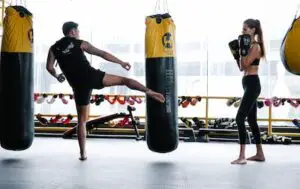Jiu Jitsu is a martial art that requires a lot of physical activity and effort from fighters. One of the key aspects of Jiu Jitsu is grappling, and in order to grapple effectively, fighters need their fingers to be strong and flexible. However, since grappling puts a lot of strain on the fingers, it is common for Jiu Jitsu fighters to tape their fingers during training and competitions. In this article, we will explore the reasons why Jiu Jitsu fighters tape their fingers and look at six sub-questions to help you better understand the importance of this practice.
What is Jiu Jitsu?
Jiu Jitsu is a martial art that originated in Japan and focuses on grappling techniques such as throws, joint locks, and chokes. It is considered a form of self-defense and is often used in mixed martial arts (MMA) competitions. Jiu Jitsu is a physically demanding sport that requires a lot of training and practice to master.
What are the benefits of practicing Jiu Jitsu?
Practicing Jiu Jitsu offers numerous health benefits, such as improved strength, endurance, and flexibility. It is also a great way to relieve stress and improve mental well-being. Jiu Jitsu can boost confidence and self-esteem, and it helps to develop self-discipline and respect.
Why do Jiu Jitsu fighters tape their fingers?
Jiu Jitsu fighters often tape their fingers to provide additional support and protection during training and competition. Here are a few reasons why taping is commonly used:
- Injury prevention: Taping helps stabilize the finger joints and reduces the risk of sprains, strains, and dislocations. Jiu Jitsu involves a lot of gripping, pulling, and joint manipulation, which can put significant stress on the fingers. Taping provides an extra layer of support to help prevent injuries.
- Joint reinforcement: Finger joints are vulnerable to hyperextension and twisting during grappling and submission attempts. Taping can help reinforce the joints, providing added stability and reducing the risk of injury.
- Grip enhancement: Taping can improve the grip by adding a layer of friction between the hand and the opponent’s clothing or skin. This can be particularly helpful when attempting holds, controlling the opponent, or executing submissions.
- Finger protection: Jiu Jitsu practitioners commonly experience finger injuries, such as jammed fingers, sprains, or minor fractures. Taping can help protect the fingers from impact and minimize the risk of these injuries.
It’s important to note that taping should be done properly to ensure effectiveness and minimize any discomfort. Different individuals may have specific taping preferences or techniques based on their hand anatomy and personal needs. It’s a good practice to consult with a qualified instructor or a sports medicine professional to learn the correct taping methods for Jiu Jitsu.
How do Jiu Jitsu fighters tape their fingers?
Taping the fingers for Jiu Jitsu involves wrapping the first two fingers together, then wrapping the remaining fingers individually. The tape should be tight enough to provide support but not so tight that it restricts movement or blood flow. The tape should be wrapped from the base of the finger to the tip, covering the knuckles and joints as well.
What are the different types of tape used for Jiu Jitsu?
There are several types of tape that can be used for Jiu Jitsu, including athletic tape, medical tape, and even duct tape. Athletic tape is the most common type of tape used and is designed to be flexible and supportive. Medical tape is similar to athletic tape but is more adhesive and may irritate the skin. Duct tape is not recommended for use in Jiu Jitsu as it is too rigid and can cause damage to the skin.
Are there any risks associated with taping fingers for Jiu Jitsu?
Though taping fingers for Jiu Jitsu is generally considered safe, there are some risks associated with improper taping. Over-taping can lead to restricted movement and decreased circulation, while under-taping can provide inadequate support and not prevent injuries. It is important to use proper technique and to not rely solely on taping for finger protection. Proper rest and recovery time should also be taken after training to prevent injuries.
Conclusion
In conclusion, taping fingers is an essential practice for Jiu Jitsu fighters to protect their fingers from injury during training and competitions. This article has explored the benefits of Jiu Jitsu, the reasons why Jiu Jitsu fighters tape their fingers, how to tape fingers for Jiu Jitsu, the different types of tape used for Jiu Jitsu, and the risks associated with taping fingers for Jiu Jitsu. By understanding the importance of this practice and using proper technique, Jiu Jitsu fighters can train safely and effectively to improve their skills and achieve their goals.





